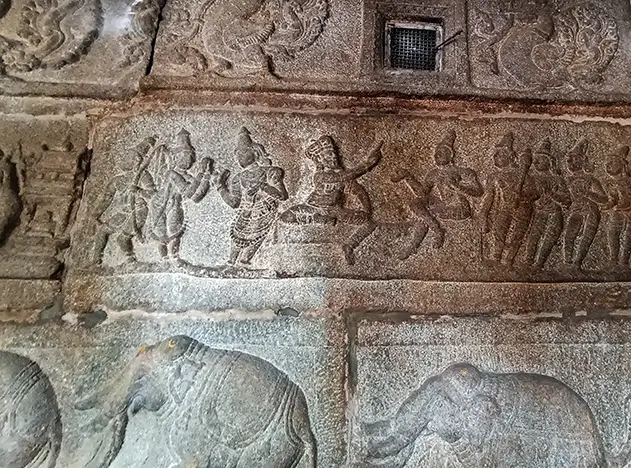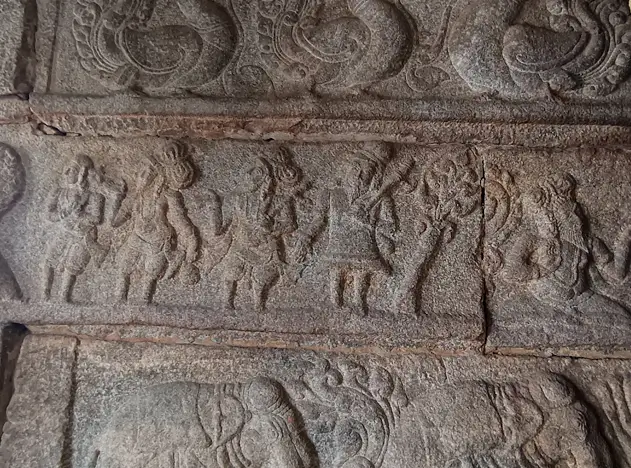Mythological Narratives
Bhikshatana Murthi and Annapoorneswari
Daksha Prajapati’s daughter Dakshaini Devi goes to her father’s yajna without being invited and is insulted by her father and jumps into the yajna and dies. In the second birth, Dakshaini was born as Goddess Parvati to Himavantu. Knowing this, Shiva could test her and came to Earth in the guise of a Bikshatana Murthi and stood in front of Parvati’s house and called her Bhavati Bhikshandehi. Hearing that, Parvati was taking a bath and wrapped her body around a necessity and brought rice and put it in a biksha pot and went inside the house to fetch milk and ghee. When Parvati arrived, he made the rice full of containing the begging bowls as a vessel. As if the donor had noticed her concentration, he slipped the cloth around her. She does not notice the slipped cloth and gives priority to the charity she is doing and continues to donate. There is an abundance of devotion but no obscenity can be seen. Lord Shiva appears in his true form before Parvati in appreciation of her devotion and devotion.
Gokarna
In this challenging moment, Ravana, ever the dutiful son, made a solemn promise to his mother. He vowed to journey to Mount Kailash, the divine abode of Lord Shiva himself, and retrieve the coveted Atmalinga for her worship. With unwavering determination, Ravana embarked on a path of intense penance and devotion on the sacred mountain. His melodious voice resonated through the heights as he sang praises of Lord Shiva through the Shiva Tandava Stotram. To demonstrate his commitment, he even resorted to a gruesome act, severing his own head and crafting a harp from the threads drawn from his own skin and intestines.
Lord Shiva, touched by Ravana’s extreme devotion, materialized before him and offered to grant him a wish. Ravana, with unwavering resolve, requested the Atmalinga as his boon. Lord Shiva consented, but with one critical condition – the Atmalinga, once placed on the ground, would become rooted in that spot for eternity, ensuring it could not be stolen or removed. With his divine boon secured, Ravana began his journey back to Lanka.


However, as Ravana neared Gokarna, a divine twist in the tale occurred. Lord Vishnu obscured the sun, creating the illusion of dusk. Ravana needed to perform his evening rituals but faced a dilemma because he could not place the Atma-Linga on the ground. At this crucial juncture, a Brahmin boy, in actuality, Lord Ganesha in disguise, approached Ravana. Ravana beseeched the young boy to hold the Atma-Linga temporarily while he completed his rituals, with the strict instruction not to place it on the ground. Ganesha, in his wisdom, struck a deal with Ravana. He promised to call Ravana thrice, and if Ravana failed to return within that time, Ganesha would set the Atma-Linga down. Ravana agreed, but he couldn’t make it back within the stipulated time. Before Ravana’s return, Lord Ganesha placed the Atmalinga on the ground, outwitting Ravana, and vanished with his cows.
In a frantic pursuit, Ravana chased one cow that was sinking into the earth. He managed to grasp only the cow’s ear as the rest of its body disappeared underground. The petrified form of this ear gave rise to the name “Gokarna,” where “gow” signifies “cow” and “karna” means “ear” in Sanskrit. Ravana’s efforts to lift the firmly fixed Shiva Linga proved futile, leaving him physically and spiritually exhausted. In recognition of the immense power and significance of the Atmalinga, he bestowed upon it the name “Mahabaleshwar,” signifying its all-encompassing might.
This legendary account has left an indelible mark on the town of Gokarna, where three sacred entities now reside: Gokarna, the cow’s ear; the venerated Atmalinga enshrined in the Mahabaleshwar Temple; and the revered Goddess Bhadrakali. These sites continue to serve as places of profound worship and devotion, integral to the fabric of Gokarna’s spiritual heritage.


The Story of Manuneethi Cholan
The story of Manuneethi Cholan, also known as Rajaraja Chola, is a legendary tale of a just and wise king from the Chola dynasty of ancient India. He is celebrated for his unwavering commitment to justice and fairness in his rule. Here’s the story of Manuneethi Cholan:
Rajaraja Chola, commonly referred to as Manuneethi Cholan, ascended to the throne of the Chola Empire in the 10th century CE. From the beginning of his reign, he demonstrated a strong sense of justice and a deep commitment to upholding dharma, the moral and ethical code of conduct.
One of the most famous anecdotes from Manuneethi Cholan’s rule involves a unique incident that showcased his sense of justice. The story goes as follows:
Once, a poor Brahmin approached King Manuneethi Cholan with a grievance. He claimed that a wealthy merchant had stolen his cow, which was his only source of livelihood. The Brahmin pleaded for justice, seeking the return of his beloved cow.
King Manuneethi Cholan was known for his impartiality, and he resolved to find a fair solution to the dispute. He summoned the merchant and questioned him about the alleged theft. The merchant vehemently denied the accusation and claimed that the cow in his possession was indeed his own.
As the king contemplated the matter, he devised a brilliant plan to determine the rightful owner of the cow. He ordered both the Brahmin and the merchant to appear before him again after a few days. During this period, the king ensured that the cow gave birth to a calf.
When the appointed day arrived, the king faced both parties and posed a unique challenge. He proclaimed that the calf would decide the cow’s rightful owner. The calf would be set free, and whoever it followed would be declared the owner of the cow. As the calf was released, it wandered aimlessly for a moment, leaving both the Brahmin and the merchant anxious. Then, to everyone’s astonishment, the calf walked straight up to the poor Brahmin and began licking his hand. The king and his courtiers witnessed this with amazement. King Manuneethi Cholan declared the Brahmin as the true owner of the cow, as the calf’s actions indicated a genuine bond between them.
The rich merchant was compelled to return the stolen cow to the Brahmin, and the king’s decision was accepted without protest. Manuneethi Cholan’s wisdom and unwavering commitment to justice earned him the title of “Manuneethi Cholan,” which translates to “Chola King of Just Rules.” His reign is remembered as a golden era of justice and ethical governance in the Chola Empire. The story of Manuneethi Cholan continues to be an enduring symbol of the importance of fairness and righteousness in leadership, and it serves as an inspirational tale of a just and wise ruler in Indian history.
The sculptures of Lepakshi Temple are not merely stone figures; they are a testament to the craftsmanship, spirituality, and cultural richness of an era long gone. As you wander through the temple’s hallowed halls, take a moment to appreciate these masterpieces in stone, for they are not just relics of the past but a living legacy of India’s artistic and spiritual heritage. Visit Lepakshi Temple to witness the dance of deities, the tales of epic heroes, and the enduring beauty of sculpted artistry.


Bakta Siriyala
Once upon a time, in a quaint village in Karnataka, there lived a simple and honest man named Siriyala. Siriyala was known for his unwavering devotion to Lord Shiva and his commitment to leading a righteous life. He was so devoted to the Lord that he was often called “Bakta Siriyala,” which means “Devotee Siriyala.”
Bakta Siriyala’s daily routine revolved around his devotion to Lord Shiva. Every morning, he would wake up before sunrise, take a ritual bath in the sacred river, and then make his way to the nearby Shiva temple. There, he would offer fresh flowers, incense, and heartfelt prayers to the deity. He would chant the name of Lord Shiva with such devotion that he was truly one with his prayers.
One day, as Bakta Siriyala was deeply engrossed in his prayers, a mischievous monkey from the nearby forest approached the temple. The monkey, drawn by the colorful flowers and the aroma of the prasad (offering), decided to take a closer look. The monkey playfully snatched some flowers and fruits and began to enjoy the prasad meant for the Lord.
As Bakta Siriyala opened his eyes to continue his prayers, he was surprised to see the monkey feasting on the offerings. But instead of getting angry or shooing the monkey away, he smiled and thought, “Even the Lord’s creatures must be hungry. Let me share the prasad with this little one.”
He gently approached the monkey and offered it some prasad. To his amazement, the monkey accepted the offering and, as if in gratitude, bowed its head before scampering back into the forest.
News of Bakta Siriyala’s kindness and devotion spread throughout the village. People were deeply moved by his selfless act of sharing the Lord’s prasad with a simple forest creature. Bakta Siriyala’s reputation as a truly righteous and compassionate devotee grew even stronger. The moral of the story is that true devotion and righteousness are not just about rituals and prayers but also about kindness, compassion, and selflessness. Bakta Siriyala’s story serves as a reminder that a pure heart, filled with love and empathy, is the most precious offering one can make to the divine.
Kiratarjuniyam
During their exile, the Pandavas found themselves in the lush forests of the Himalayas. One day, Arjuna, the third Pandava and a formidable archer, ventured deep into the woods for a hunt. Arjuna was renowned for his prowess with the bow and arrow, and he relished the thrill of the hunt. As Arjuna roamed the forest, he encountered an awe-inspiring sight—a magnificent and towering Kirata, a powerful hunter who was none other than Lord Shiva in disguise. The two mighty warriors, Arjuna and Shiva, met in the dense wilderness, unaware of each other’s true identities. A fierce battle ensued between them. Arjuna, a skilled warrior, used his exceptional archery skills, unleashing a barrage of arrows with unparalleled precision. On the other hand, Shiva, in his Kirata form, matched Arjuna’s prowess with his own divine strength and weaponry.
The battle raged on for days, with neither Arjuna nor the Kirata able to gain the upper hand. Arjuna was astounded by the Kirata’s resilience and strength. Recognizing that he was facing someone extraordinary, he decided to approach the Kirata with respect. Arjuna laid down his bow and arrows and revealed his true identity as a prince of the Kuru dynasty and a devotee of Lord Shiva. He sought the Kirata’s blessings and asked for forgiveness for not recognizing his divine presence. Lord Shiva, pleased with Arjuna’s humility and devotion, revealed his true form as the mighty Lord of Destruction. He blessed Arjuna and bestowed upon him divine weapons and knowledge, enhancing his already formidable skills. Shiva’s blessings and teachings served Arjuna well in the later episodes of the Mahabharata, including the great war of Kurukshetra.
Arjuna returned to his brothers, sharing the tale of his encounter with Lord Shiva in the form of the Kirata. The Pandavas were in awe of the divine intervention and blessings that Arjuna had received in the forest. This story of Arjuna’s encounter with Kiratarjuna became a testament to the divine grace and the recognition of devotion and humility. The Kiratarjuniyam story is not only a thrilling battle episode but also a profound spiritual lesson, emphasizing the significance of humility, devotion, and recognizing the divine even in unexpected forms. It illustrates that true strength lies not only in physical prowess but also in humility and reverence for the divine.








